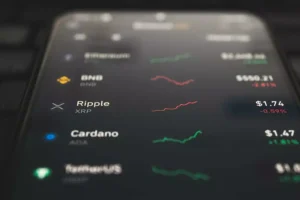When you first begin exploring cryptocurrencies and diving into trading, you are at a crossroads with many options. Traders frequently try to get the most out of their earnings. Therefore, they choose between the most sought-after crypto trading methods – spot trading vs margin trading. Every investor must comprehend the distinctions between these two approaches to navigate the unstable cryptocurrency markets successfully. In this blog article, we’ll explore the distinctions between spot vs margin trading.
How Margin Trading Works
The completion of agreements on the purchase or sale of shares for a stock broker’s money is known as margin trading. In this type of trading with leverage, you must employ borrowed and personal funds when trading virtual coins. In the transaction, the trader invests a portion of their own money and a portion of borrowed funds. Take, as an example, a 10:1 ratio. As a result, both the overall investment and the trade’s outcome boost. The borrowed money is returned to the lender after the transaction, and the positions are closed, but the trader preserves the earnings.


Turnkey Brokerage Solution For Your Business
Get the most profitable fully licensed fx/crypto brokerage software or ready-to-operate business in 48 hours. Best-in-class web & mobile trading platforms, sales-driven CRM, full integration with MT4/5, and 150+ payment providers.
Pros and cons
There are several noteworthy benefits associated with this trading strategy. Let’s examine the primary positive sides:
- Leverage allows you to open a deal for a more considerable amount than you would wish to utilize.
- The client can trade using margin leverage. You’re free to choose between long and short positions.
- A trader can initiate leveraged bets, either long or short, without having to sell the asset.
It’s also essential to consider the drawbacks. As an illustration, it may be highly cumbersome to deposit funds to a particular pair, lend money, initiate a transaction, terminate it, and figure out how much you have to repay if you employ an isolated margin.
How Spot Trading Works
Trade occurring on the spot market is known as spot trading. Traders submit orders to the exchange. To arrange the auction, the platform “aggregates” the applications from each user and charges a commission. Here, the client notifies the platform of the asset and its quantity by sending a market order. No more information is required because the broker or cryptocurrency exchange will know the trader’s goals and the price they are ready to purchase or trade. The outcome of recent transactions on the asset demarcates the price in spot trading on the exchange. Customers can order at their spot trading fee if they are unhappy with the current pricing.


Turnkey Brokerage Solution For Your Business
Get the most profitable fully licensed fx/crypto brokerage software or ready-to-operate business in 48 hours. Best-in-class web & mobile trading platforms, sales-driven CRM, full integration with MT4/5, and 150+ payment providers.
Pros and cons
There are multiple benefits and hazards associated with the spot market. One of the finest benefits is a lower cost compared to future contracts. A clear set of regulations makes it easier to participate in trades, and additional benefits include anticipated profitability of operations, the option to start transactions for any length of time, and a straightforward entrance threshold.
Let’s not overlook the drawbacks either:
- the requirement to comprehend asset characteristics;
- spot markets have a lower profit margin potential than can offer forward, margin, or futures markets.
In any case, it’s an excellent way for newbies to become familiar with the realm of crypto.

Spot Trading vs Margin Trading
There are several methods of purchasing and disposing of financial products. Spot vs margin trading are among the most demanded options, which differ significantly. To determine what to choose, let’s compare them.
| Spot trading | Margin trading |
| Immediate settlement | Short sale |
| It is possible to settle every transaction “on the spot”. Ownership of the asset transfers instantly upon the termination of the agreement. | When you can borrow money and sell assets you don’t own, aiming to buy it back later when it’s cheaper, that’s short selling. It’s a way to make money when things you sell go down in value. |
| Without borrowings | Borrowing and leverage |
| It has to do with buyers and sellers exchanging assets directly. Typically, no borrowing nor leverage are present. | To expand your revenue, you might take out a loan. Leverage is possible for you in this case. |
| Low risk | Increased risk |
| Since you don’t need to borrow money, you risk only your own invested sum. | Higher risk is included, because you raise not only gains but also losses in this way. |
| Limited profit potential | Increased profit potential |
| The real price movement of the item determines the maximum profit possibility in spot trading. Only the asset’s price shift determines whether traders will profit or lose. | Leverage may boost returns by enabling you to hold bigger positions with less cash. |
To cap it all, what distinguishes the spot system apart from margin trading is that margin permits you to utilize the borrowed capital of the margin exchange as security to your own assets, with the payment of a commission.
Platforms that Offer Spot and Margin Crypto Trading
These days, rookies and seasoned traders can find amazing options where to trade. Business owners aim to create an engaging environment with endless opportunities. Many cryptocurrencies are often offered for spot vs margin trading to give traders a wide selection of alternatives.
Let’s touch on other critical features that platforms should provide:
- Leverage Options: It is essential to evaluate the range of leverage options available. Higher leverage can amplify both gains and losses, so choose a platform that aligns with your risk tolerance.
- Asset Coverage: Traders should check the variety of cryptocurrencies offered for trading. A comprehensive list ensures you can explore different assets within the same platform.
- Risk Management Tools: Stop-loss orders and take-profit options are crucial. These tools help mitigate potential losses and secure profits automatically.
- Security Measures: Clients prioritize platforms with top-tier security protocols. Two-factor authentication, cold storage for assets, and encryption are essential for safeguarding your funds.
- Liquidity: It ensures you can execute trades swiftly without significant price slippage. Traders choose platforms with active trading volumes.
XCritical values its clients and offers the best-in-class crypto exchange. It’s a fast setup that lets you start your business within two days. Here, traders can buy, sell, and exchange tokens with ease. Moreover, you have the option to choose White label exchange software. Thanks to its quick and all-inclusive solution and strong dedication to security, businesses may now provide a full range of trading services with XCritical.






